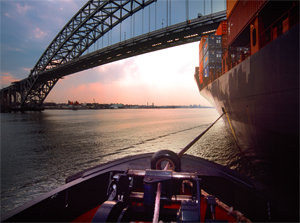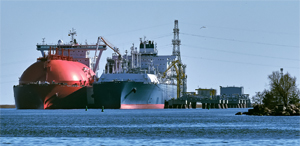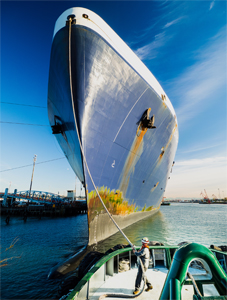Cordage, mainly towing and mooring lines, is being required to do more in a new maritime age as cargo vessels get larger and tugboats get more powerful. In response, manufacturers have continued to innovate.
Global shipping giants Wilhelmsen and Maersk, for example, are adopting a technology called the Snap Back Arrestor (SBA) for mooring lines. Developed by Norway-based Timm Ropes, it includes a special core within the rope that elongates more than the surrounding fibers, acting to absorb and dampen the energy released when lines part under strain.
SBA is significant because mooring is one of the most dangerous duties for crews and port workers. Snap back accounts for 60 percent of mooring accidents, with one in seven of those incidents resulting in a fatality, according to the UK P&I Club.
Sarah Padilla, technical director at the Cordage Institute in Wayne, Pa., said there are also plenty of other new developments coming from the industry. She cited DSM, the Netherlands-based maker of Dyneema, which has worked with partners to develop synthetic-fiber chains for anywhere traditional maritime chains are used. “These chains help with human-factor ergonomics by being lightweight, thereby reducing potential back injuries,” Padilla said.
Evolving needs and solutions
In North America, the cordage market has been dominated by a few large companies, some manufacturing here and others internationally. Among the most noteworthy and innovative players are Cortland (Puget Sound Rope) and Samson Rope in the United States, and Novabraid in Canada.
Michelle Jarvis, commercial marine product manager at Samson Rope, said customers are typically looking for durability, a predictable product lifetime, condition evaluation programs to plan replacement cycles, resilience to extreme loading conditions, reduced risk exposure for crew safety, efficiency on board, and remote support for training and inspections. Developments in the size of vessels and their use patterns have helped shape manufacturer responses to these basic needs.
 |
|
The tugboat Gramma Lee T. Moran works the flank of a containership with a Cortland line. The cordage maker mimics real-world conditions at a 600-ton tensile test bed in Houston. |
|
Courtesy Cortland |
For example, Jarvis cited floating storage regasification units (FSRUs) such as Challenger, currently the world’s largest such vessel, and others that are operating as liquefied natural gas (LNG) vessels while waiting for their permanent mooring. For large FSRUs that are moored for long periods, they need a rope that is designed for optimum durability, with high-tension fatigue resistance, abrasion resistance and ultraviolet resistance such as Samson’s EverSteel-X, she said.
Jarvis said Samson is seeing increased demand from operators of smaller vessels who have traditionally used steel wire but are making the switch to high-performance synthetics. In addition, a growing number of operators who were traditionally using commodity ropes (polyester-polypropylene blends) are jumping up to high-performance ropes to improve safety and extend replacement cycles.
For vessels that spend only a few days per month in port, lines are not under continuous tension and do not require the highest degree of tension-fatigue resistance. But they must be durable enough to hold up under the frequent handling required to moor and release a vessel over a long period, Jarvis said.
“What we are noticing more than anything is the need for a range of options to best fit the vessel, the conditions it will experience and the expected lifetime,” she said.
A specific recent market driver has been the Oil Companies International Marine Forum (OCIMF) Mooring Equipment Guidelines Fourth Edition 2018 (MEG4). “That has definitely had an impact on the choices in mooring products,” Jarvis said.
The changes cover design, maintenance, user behavior, and products and services needed to support the guidelines. As a result, Samson has made large investments in a wide range of MEG4-certified products and has increased available line sizes and training, as well as service and inspection programs. These programs include fully remote options for training, inspections and consultations, which given current social-distancing needs is very timely, Jarvis said.
In parallel with OCIMF’s release of its Static Towing Assembly Guidelines in April, Samson recently completed a successful trial and technical study in a static towing application, and has developed product options and guidance to create optimal synthetic systems to replace steel wire under various conditions, Jarvis said.
At Cortland, founded as Puget Sound Rope in 1979, a similar blend of motivations drives innovation and custom solutions. Engineering manager Thanasis Varnava said that testing is a constant activity at Cortland, not just to come up with new products but also to improve existing ones. For instance, the company’s engineering facility in Houston includes a 600-ton tensile test bed. Because it is equipped with 200-horsepower hydraulic pumps, it can go through far more cycles in a given span of time, closely mimicking real-world conditions on the water.
“We can simulate tension-to-tension sequences,” along with bending stresses to increase the efficiency of the product, Varnava said. Testing also can help to formulate accurate longevity estimates. “Customers like to get … the full life and then know it is time to take the line out of service before anything is likely to go wrong,” he explained.
Ian Watton, technical sales manager for Cortland in Green Bay, Wis., said he makes a point of always getting out on the water with mariners when he is making his sales rounds. “When I am on the boat and they are doing work, I am picking their brains to learn what they like or dislike, and I bring those concerns back to our engineering department,” he said.
Recently, a concern was expressed about the need for a “softer” line that would be light, easy to handle, and would provide good grip on bitts. “We got to work right away and went through our toolbox to develop something for that need,” Varnava said.
Although generally focusing on smaller-diameter ropes, Nova Scotia-based Novabraid has some penetration in the smaller-craft towing market, said Chuck Gilchrest, marketing and business development manager for the manufacturer’s U.S. market. He said towboats use Novabraid’s Oletec-12 line, a hollow braided 12-strand rope using 100 percent polyolefin co-polymer fiber.
Gilchrest said the company’s ultra-high molecular weight polyethylene (UHMWPE) Spectra fiber, which has very high strength, is much in demand. “In terms of mooring lines, we are also seeing more and more companies switching from nylon, which has been standard, to polyester,” he said. Since a mooring line typically has a good catenary, “stretchiness isn’t as required,” he explained. Polyester also reduces water absorption and helps alleviate potential reduction in tensile strength.
 |
|
Specialized needs, specialized products. Floating storage regasification units, center, are moored for longer periods and require cordage designed for increased durability and fatigue resistance. |
|
Courtesy NPersha/Adobe Stock |
Future trends
According to Padilla, the Cordage Institute and EuroCord are partnering to promote circular design development, which focuses on life-cycle management for fishing gear in particular before it gets abandoned or lost at sea. “We are also encouraging the collection of larger marine ropes as well, as the size of larger ropes sometimes makes them easier to recycle,” she said.
The Cordage Institute is also working on several testing guidelines and standards as a way to improve safety for marine and other industries. Having standardized testing will make it easier for purchasers to compare data, Padilla said. “We just finished an abrasion test guideline,” she said, adding that a cyclic bend over sheave (CBOS) guideline and cut test guideline also are in the works. These guidelines aim to educate users on what terminology is associated with each test, and the variables and potential pitfalls to consider when designing tests.
At Samson, Jarvis said the company is looking toward continued enhancement of remote training, inspection and line tracking for both mooring and towing operations. “We continue to look at systems innovations and compatibility beyond individual rope components,” she said.
Gilchrest at Novabraid said he doesn’t see any major product changes on the horizon, but he did point out a development for commercial fishing that should be helpful for all mariners. “We are starting to offer breakaway lines for commercial fishing, namely lobster and crab pots, to help protect the North Atlantic right whale,” a concern that has been affecting commercial marine operations across the board in areas such as the Gulf of St. Lawrence, he said.
“The other thing that is potentially going to affect the market is trade and tariff regulations that may affect the cost of marine cordage,” Gilchrest said. “Novabraid is one of the few manufacturers that builds exclusively in North America, but we are still trying to sort out the USMCA agreement (a new trade pact) between the U.S., Canada and Mexico.”

